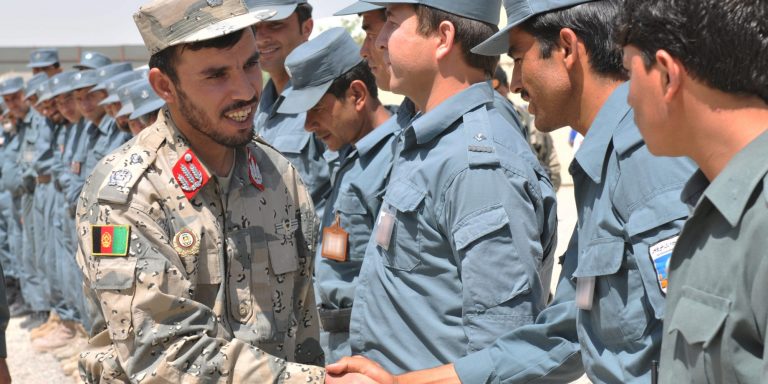INTELBRIEF
October 19, 2018
IntelBrief: The Taliban’s Devastating Attack in Kandahar

- On October 18, the Taliban assassinated General Abdul Raziq, the extremely powerful and controversial police chief of Kandahar Province.
- The Governor of Kandahar, Zalmai Wesa, was injured in the attack, while the province’s intelligence chief, Gen. Abdul Momin, was killed.
- The head of U.S. military forces in Afghanistan, General Miller, was also at the meeting and was uninjured following the attack.
- The latest insider attack is among the most devastating in the long-running Afghan war.
.
The Afghan government’s fight against the Taliban in Kandahar Province, where the Taliban first formed nearly 24 years ago, suffered yet another significant setback in an what has been a painful stalemate. On October 18, the Taliban claimed credit for what appears to be an insider attack aimed at the most powerful government officials in southern Afghanistan. At least one gunman opened fire at a high-level meeting in Kandahar where, among those present, was the commander of all U.S. forces in Afghanistan, General Austin S. Miller. The Pentagon released a statement clarifying that General Miller was uninjured; two other U.S. service personnel were injured during brief exchange of gunfire.
The attack did succeed in killing General Abdul Raziq, the police chief of Kandahar, and an individual likely at the very top of the Taliban’s ‘hit list,’ given his outsized influence, notoriety and reputation. General Raziq has received strong support from the United States despite allegedly overseeing numerous incidents of torture and extra-judicial killings in detention centers operated by his police force. General Raziq was credited with helping the Afghan government regain a modicum of stability and security in the crucial province, which has long been a Taliban stronghold. It is difficult to overstate just how much the U.S. has relied on General Raziq in the last several years. The incident is reminiscent of previous attacks in Afghanistan. In July 2011, Ahmad Wali Karzai, the de facto ruler of Kandahar and half-brother of then-president Hamid Karzai was assassinated, also by one of his guards.
From the onset of the war in Afghanistan, the U.S. has never been able to achieve sustained progress in balancing corruption versus security. From the earliest days of the U.S. invasion and through the last 17 years, Washington has repeatedly turned to warlords with atrocious human rights records to help fight the Taliban. While occasionally successful in the short term, there are long-term costs to working closely with warlords and other sub-state actors. When these individuals and the groups they command are implicated in egregious human rights abuses, it works to tilt the conflict back into the Taliban’s favor, pushing the local population to support the insurgents. The U.S. strategy of ‘wining hearts and minds’ has never gained much traction in Afghanistan because the U.S. has continuously supported Afghan officials more known for poor governance and greed than anything resembling political legitimacy. Corruption—and its corrosive effects on society—is perhaps the single greatest factor in the coalition and Afghan government’s inability to reverse steady and significant losses across the country.
The meeting in Kandahar was held to discuss important security preparations for the upcoming parliamentary elections, scheduled to be held on October 20. Even before this attack, the elections were under extreme threat by the Taliban and the Islamic State in Khorasan Province, or ISKP. Many polling stations will be closed due to the threat. The U.S. and the Afghan governments, as well as the country writ large, need successful elections to occur in order to demonstrate progress. Still, elections by themselves will achieve little if the systemic corruption and support of rapacious warlords continues in perpetuity.
The insider attack is doubly damaging because, in addition to upending the leadership of Kandahar, it serves to further drive a wedge between the Afghan rank and file and their leaders, to say nothing of straining the U.S.-Afghan relationship. These ‘green on green’ (Afghan on Afghan) or ‘green on blue (Afghan on Coalition) attacks are poison to the workability of effective embedded training, and ‘advise and assist’ missions. This approach is the foundation of the entire war effort for the U.S., and the threat of insider attack obviates that strategy. The U.S. effort in Afghanistan, and the outlook for the U.S.-supported Afghan government in Kabul and the Provincial governors, suffered a significant loss in the October 18th Kandahar attack at a particularly sensitive moment. These insider attacks are a deliberate tactic used by the Taliban to achieve strategic effects. If the United States and the Afghan government prove unable to protect their leadership, respectively, future attacks could very well achieve the tipping point that the insurgents are aiming for and compel the U.S. to withdraw its remaining troops from Afghanistan once and for all.
.
For tailored research and analysis, please contact: info@thesoufancenter.org
[video width="960" height="540" mp4="https://thesoufancenter.org/wp-content/uploads/2018/10/IB-1019.mp4" poster="https://thesoufancenter.org/wp-content/uploads/2018/10/Afghan_Brig._Gen._Abdul_Raziq_shakes_hands_with_Afghan_police_instructors_at_Kandahar_Regional_Training_Center_-1-e1539899053978.jpg"][/video]